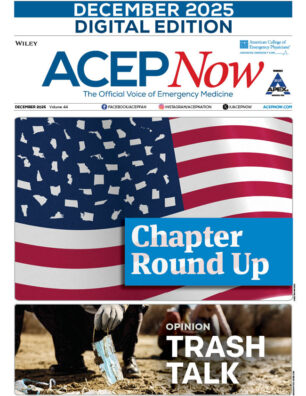The Affordable Care Act (ACA) requires that the Centers for Medicare & Medicaid Services (CMS) implement a value-based payment modifier that would apply to Medicare fee-for-service payments starting with select physicians on January 1, 2015, and applying to all physicians and groups by January 1, 2017. The value-based modifier (VBM) is intended to pay physicians differentially based on the quality and cost of their care.
Explore This Issue
ACEP News: Vol 32 – No 01 – January 2013How to Avoid the VBM Penalty in 3 Easy Steps
To be held harmless under the VBM in 2015, group practices of 100 or more eligible professionals should follow the three easy steps outlined below.
- PECOS: Since CMS will gather information such as a physician’s specialty and group practice affiliation from PECOS for both the Physician Feedback Reports and the VBM, it is important that you make sure your practice data is up-to-date by visiting https://pecos.cms.hhs.gov.
- Self-Nominate for PQRS: Groups of greater than 100 EPs have to self-nominate to participate in one of the PQRS Group Practice Reporting Options (GPROs) by October 15, 2013 via the CMS Communications and Support website.
- Successfully Report PQRS:
- Satisfy the reporting criteria for the 2013 PQRS incentive via either the GPRO registry reporting option or the GPRO Web Interface (see www.acep.org/quality/pqrs);-OR-
- Elect to be analyzed under the PQRS administrative claims-based reporting option by Oct. 15, 2013
ACEP recommends that all ED-based and Hospital-based groups complete the group practice self-nomination process and elect the administrative claims reporting option to avoid the 2015 PQRS and 2015 VBM penalties AND the members of your group then continue to report the traditional claims-based measures as individuals in order to earn the PQRS incentive in 2014 based on the 2013 reporting period. The administrative claims option means that CMS will review your practice’s claims and abstract certain quality metrics. Since the measures do not apply to emergency department care, your practice will have a denominator of zero for these measures and the practice will avoid the 1% VBM penalty in 2015. ACEP also recommends that groups DO NOT elect the quality tiering option for 2015. The program is still not completely fleshed out and more information will be needed before any recommendation could be made for emergency physicians. For more information for practices that include other physicians or office based specialists as well as the different PQRS reporting options for incentives and penalties including the VBM, please see www.acep.org/quality/pqrs.




No Responses to “Physician value-based payment modifier starts in 2015”